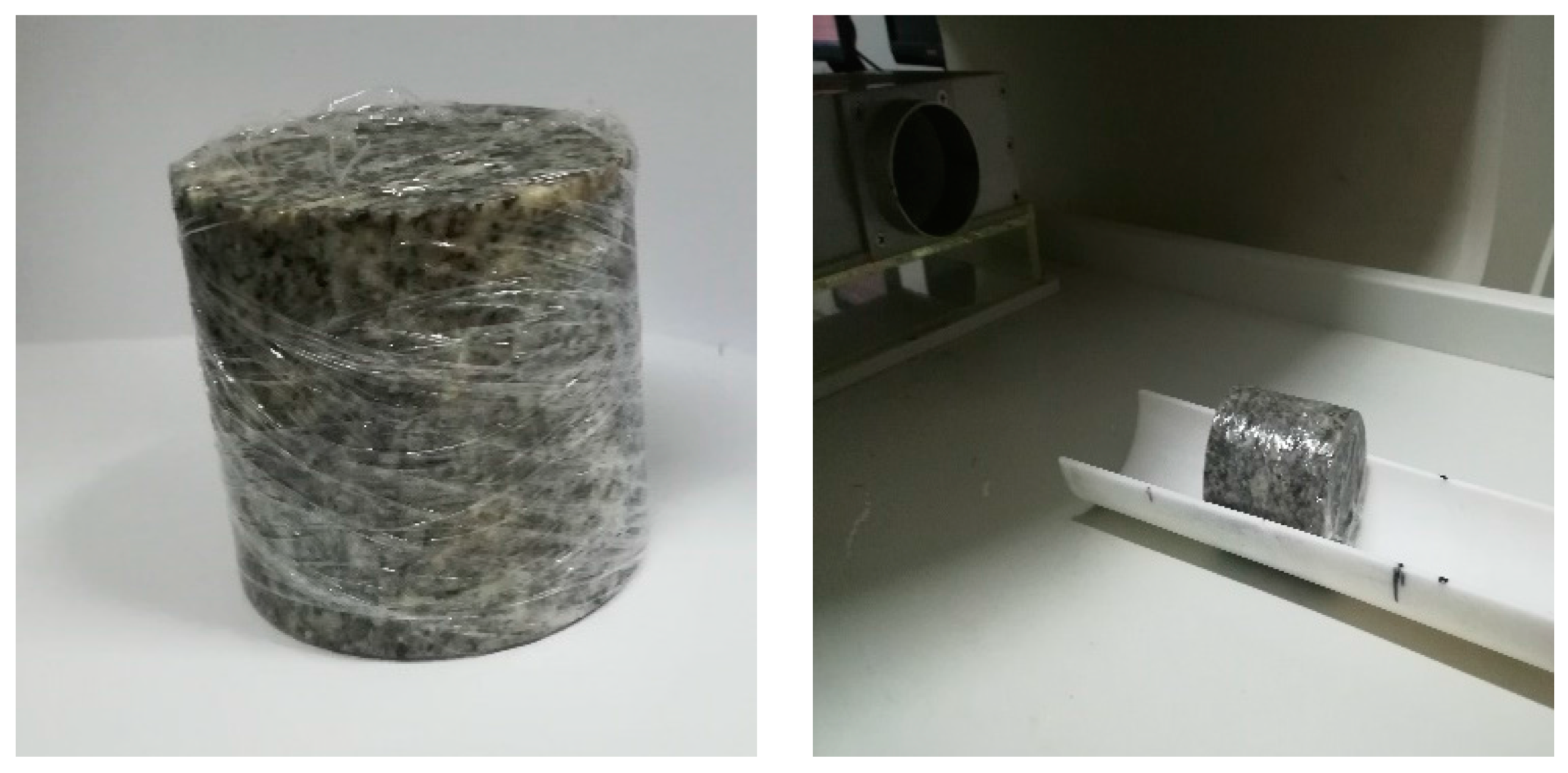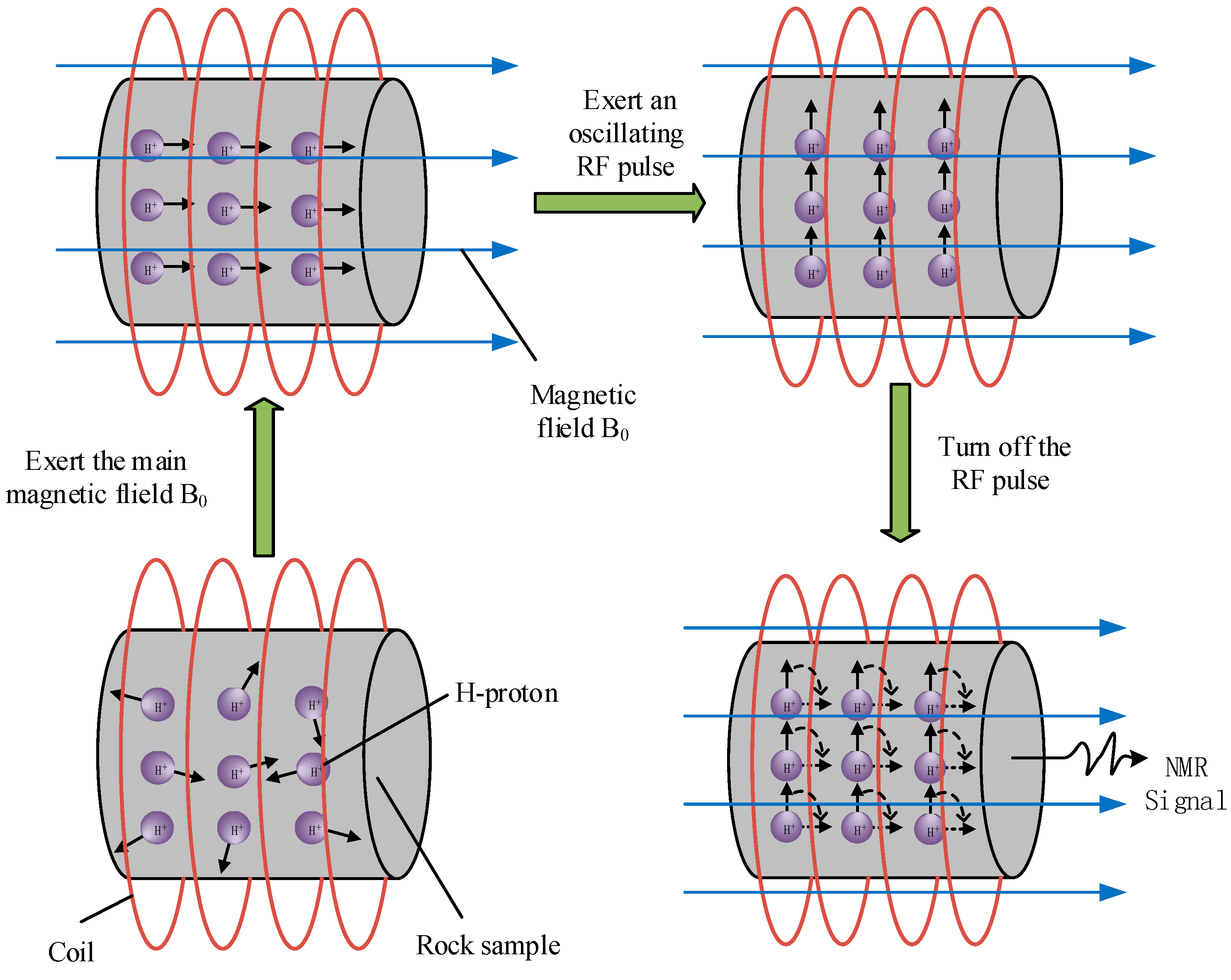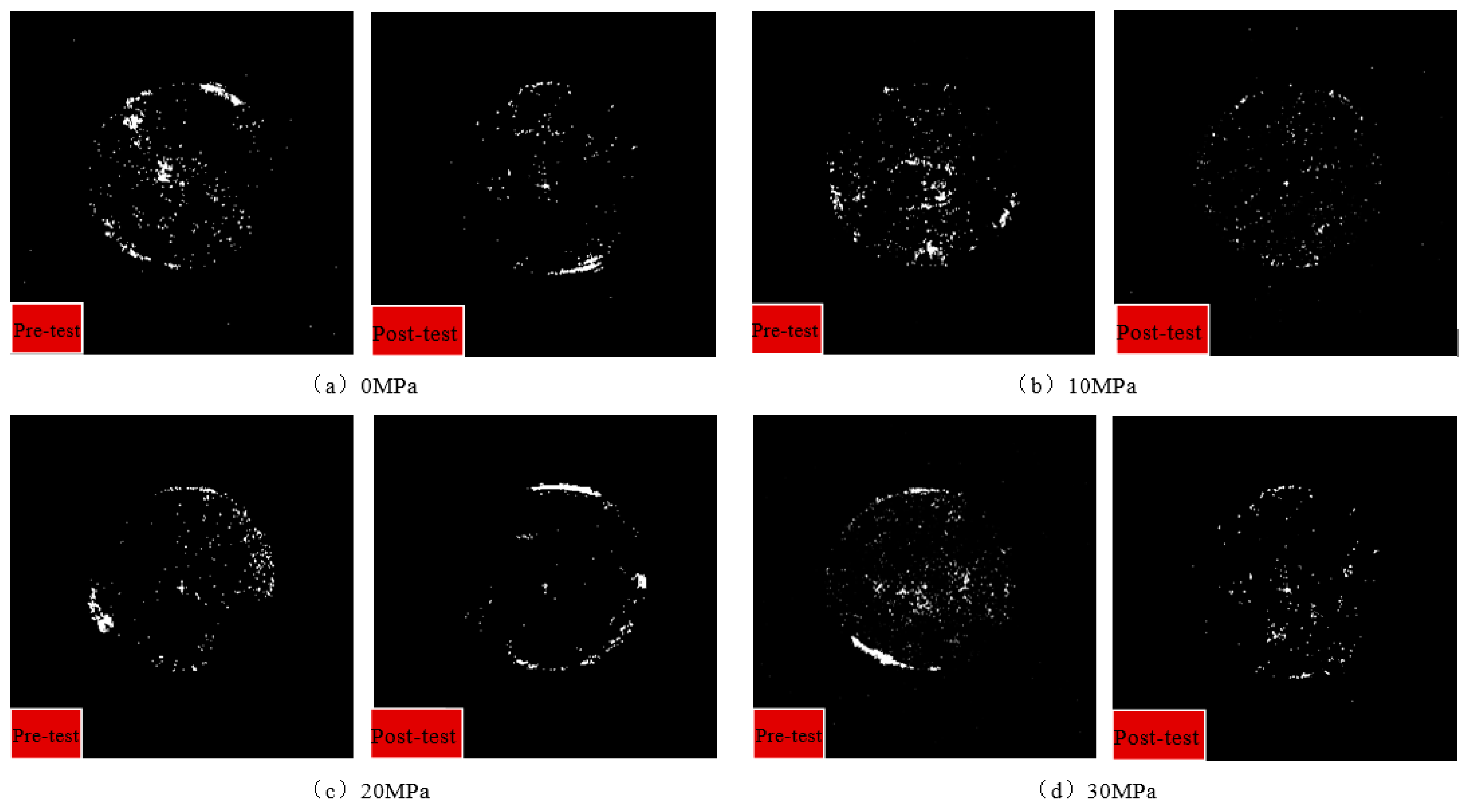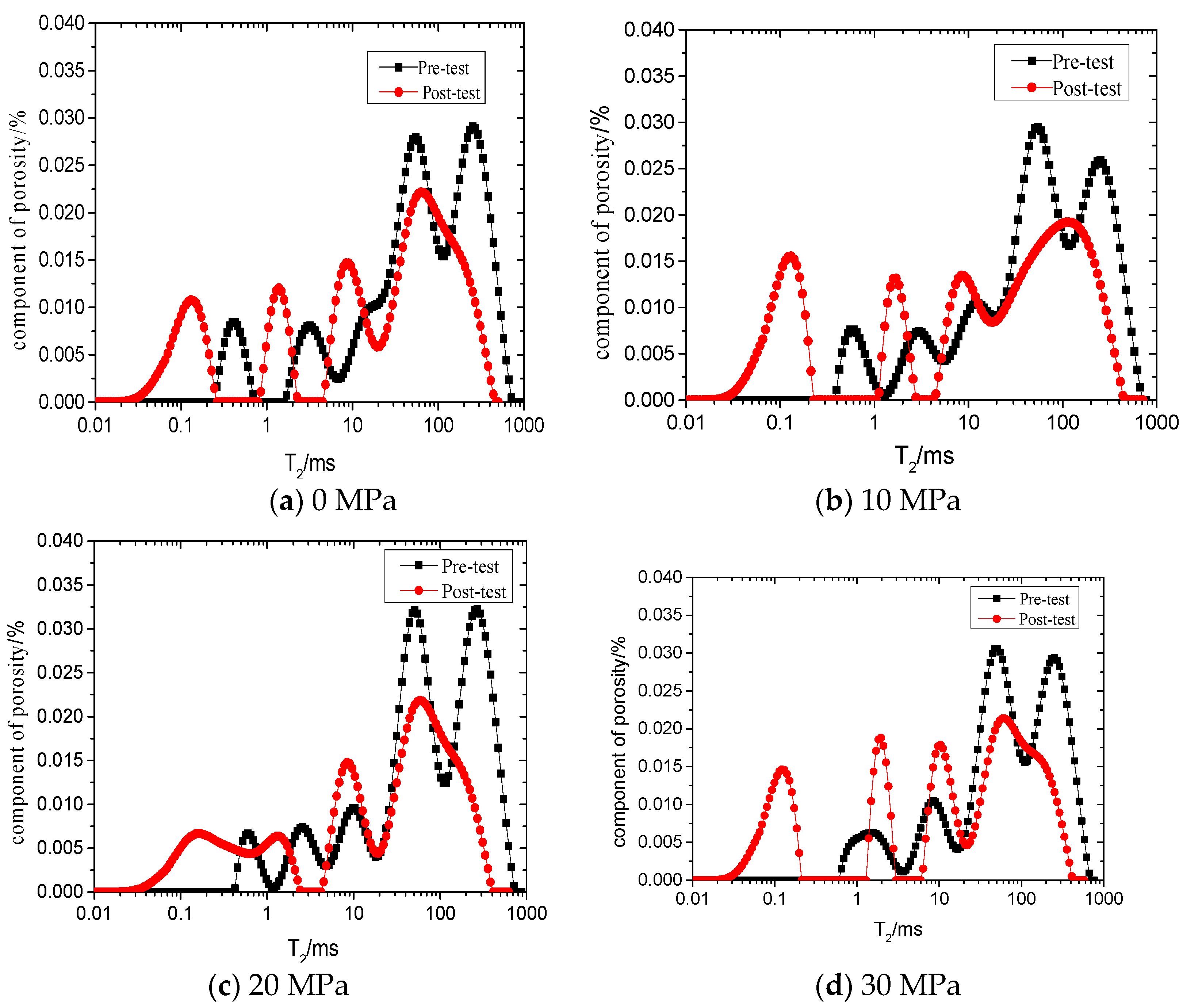Time-Varying Characteristics of Granite Microstructures after Cyclic Dynamic Disturbance Using Nuclear Magnetic Resonance
Abstract
:1. Introduction
2. Materials and Methods
2.1. Materials
2.2. Experimental Procedure
2.3. Test Mechanism
2.3.1. MRI Test
2.3.2. T2 Spectrum Test
2.3.3. SHPB Test
3. Results and Discussion
3.1. The P-Wave Rebound Phenomenon
- (a)
- The P-wave velocity first decreases and then increases with time after removing the samples from the SHPB device. In addition, the P-wave velocity is sensitive to the time effect at the initial stage of the curve.
- (b)
- When the axial pre-stress is 0 MPa, the P-wave velocity decreases by 468 m/s, the steepest declining trend is shown, and it reaches 11.8% compared to the velocity before the test. The P-wave velocities of the other samples declined by 6.1%, 5.3%, and 3.8%.
- (c)
- The P-wave velocity can rebound to the initial velocity and can even become much greater than it. The growth rates are 1.60%, 2.50%, 3.31%, and 3.28%.
3.2. Magnetic Resonance Images (MRI)
3.3. T2 Spectrum
4. Conclusions
Acknowledgments
Author Contributions
Conflicts of Interest
References
- Lindqvist, J.E.; Åkesson, U.; Malaga, K. Microstructure and functional properties of rock materials. Mater. Charact. 2007, 58, 1183–1188. [Google Scholar] [CrossRef]
- Johansson, E. Technological Properties of Rock Aggregates. Ph.D. Thesis, Luleå University of Technology, Luleå, Sweden, 2011. [Google Scholar]
- Hztzor, Y.H.; Zur, A.; Mimran, Y. Microstructure effects on microcracking and brittle failure of dolomites. Tectonophysics 1997, 281, 141–161. [Google Scholar] [CrossRef]
- Tuğrul, A.; Zarif, I.H. Correlation of mineralogical and textural characteristics with engineering properties of selected granitic rocks from Turkey. Eng. Geol. 1999, 51, 303–317. [Google Scholar] [CrossRef]
- Ods, S.; Li, S.G. The shape distribution of the cracks produced in the rock under uniaxial compressive stress. Glob. Geol. 1989, 4, 177–180. [Google Scholar]
- Yue, Z.Q.; Chen, S.; Zheng, H.; Tham, L.G. Digital image proceeding based on finite element method for geomaterials. Chin. J. Rock Mech. Eng. 2004, 23, 889–897. [Google Scholar]
- Chen, S.; Yue, Z.Q.; Tan, G.H. Digital image based numerical modeling method for heterogeneous geomaterial. Chin. J. Geotech. Eng. 2005, 27, 956–964. [Google Scholar]
- Yue, Z.Q.; Chen, S.; Thaml, L.G. Finite element modeling of geomaterials using digital image processing. Comput. Geotech. 2003, 30, 375–397. [Google Scholar] [CrossRef]
- Prikryl, R. Some microstructure aspects of strength variation in rocks. Int. J. Rock Mech. Min. 2001, 38, 671–682. [Google Scholar] [CrossRef]
- Rune, M.H. Petrophysics Under Stress. In Proceedings of the 6th Nordic Symposium on Petrophysics, Trondheim, Norway, 15–16 May 2001. [Google Scholar]
- Fjaer, E.; Holt, R.M. Stress and Stress Release Effects on Acoustic Velocities from Cores, Logs and Seismics. In Proceedings of the SPWLA 40th Annual Logging Symposium, Oslo, Norway, 30 May–3 June 1999; Society of Petrophysicists and Well-Log Analysts: Houston, TX, USA, 1999. [Google Scholar]
- Nafi Toksoz, M.; Cheng, C.H.; Timur, A. Velocities of seismic waves in porous rocks. Soc. Explor. Geophys. 1976, 41, 621–645. [Google Scholar]
- Coates, G.R.; Xiao, L.; Prammer, M.G. NMR Logging Principles and Application; Meng, F.Y., Ed.; Petroleum Industry Press: Beijing, China, 2007; pp. 36–39. [Google Scholar]
- Zhou, K.; Hu, Z.; Li, J.; Gao, F.; Wang, M. Study of marble damage evolution laws under unloading conditions based on nuclear magnetic resonance technique. Chin. J. Rock Mech. Eng. 2014, 33, 3523–3530. [Google Scholar]
- Li, X.; Zhou, Z.; Ye, Z.; Ma, C.; Zhao, F.; Zuo, Y.; Hong, L. Study of rock mechanical characteristics under coupled static and dynamic loads. Chin. J. Rock Mech. Eng. 2008, 27, 1387–1395. [Google Scholar]
- Li, X.; Zhou, Z.; Lok, T.S.; Hong, L.; Yin, T. Innovative testing technique of rock subjected to coupled static and dynamic loads. Int. J. Rock Mech. Min. Sci. 2008, 45, 739–748. [Google Scholar] [CrossRef]
- Li, X.B.; Zhou, Z.L.; Hong, L.; Yin, T.B. Large diameter SHPB tests with a special shaped striker. ISRM News J. 2009, 12, 76–79. [Google Scholar]
- Ge, H.K.; Chen, Y.; Lin, Y.S. Microscopic mechanism of difference between static and dynamic elastic parameters of rock. J. Univ. Petrol. 2001, 25, 34–36. [Google Scholar]
- Zhou, W.; Yang, H.X. Effects of fractures of rock on elastic property of rock and velocity-porosity relation. Oil Geophys. Prospect. 2005, 40, 334–338. [Google Scholar]
- Kuster, G.T.; Nafi Toksoz, M. Velocity and attenuation of seismic waves in two-phase media: Part I. & Part II. Geophysics 1974, 39, 587–618. [Google Scholar]
- Cheng, C.H.; Nafi Toksoz, M. Inversion of seismic velocities for the pore aspect ratio spectrum of a rock. J. Goephys. Res. 1979, 84, 7533–7543. [Google Scholar] [CrossRef]









| Composition | SiO2 | Al2O3 | K2O | Fe2O3 | CaO | TiO2 |
|---|---|---|---|---|---|---|
| Content/% | 77.04 | 15.58 | 4.01 | 1.73 | 1.18 | 0.27 |
| TW/ms | RG1/db | DRG1 | TD | NECH | TE/ms | NS |
|---|---|---|---|---|---|---|
| 1500 | 20 | 3 | 109572 | 2048 | 0.22ms | 64 |
| Axial Pre-Stress (MPa) | Pre-Test Porosity (%) | Post-Test Porosity (%) | Variation (%) |
|---|---|---|---|
| 0 | 1.47 | 1.15 | –21.8 |
| 10 | 1.43 | 1.15 | –19.6 |
| 20 | 1.40 | 1.11 | –20.7 |
| 30 | 1.46 | 1.16 | –20.5 |
| Axial Pre-Stress (MPa) | The Proportion of Small Pores Before the Test (%) | The Proportion of Small Pores After the Test (%) | Variation (%) |
|---|---|---|---|
| 0 | 16.58 | 36.32 | 19.74 |
| 10 | 17.36 | 38.81 | 21.45 |
| 20 | 16.25 | 37.41 | 21.16 |
| 30 | 15.85 | 37.54 | 21.69 |
© 2017 by the authors. Licensee MDPI, Basel, Switzerland. This article is an open access article distributed under the terms and conditions of the Creative Commons Attribution (CC BY) license (http://creativecommons.org/licenses/by/4.0/).
Share and Cite
Liu, C.; Deng, H.; Wang, Y.; Lin, Y.; Zhao, H. Time-Varying Characteristics of Granite Microstructures after Cyclic Dynamic Disturbance Using Nuclear Magnetic Resonance. Crystals 2017, 7, 306. https://doi.org/10.3390/cryst7100306
Liu C, Deng H, Wang Y, Lin Y, Zhao H. Time-Varying Characteristics of Granite Microstructures after Cyclic Dynamic Disturbance Using Nuclear Magnetic Resonance. Crystals. 2017; 7(10):306. https://doi.org/10.3390/cryst7100306
Chicago/Turabian StyleLiu, Chuanju, Hongwei Deng, Yuan Wang, Yun Lin, and Huatao Zhao. 2017. "Time-Varying Characteristics of Granite Microstructures after Cyclic Dynamic Disturbance Using Nuclear Magnetic Resonance" Crystals 7, no. 10: 306. https://doi.org/10.3390/cryst7100306





